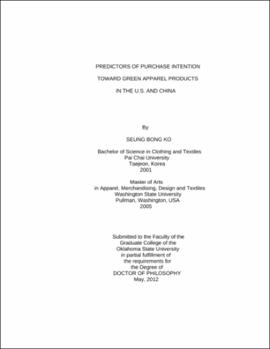| dc.contributor.advisor | Jin, Byoungho | |
| dc.contributor.author | Ko, Seung Bong | |
| dc.date.accessioned | 2013-11-26T08:23:22Z | |
| dc.date.available | 2013-11-26T08:23:22Z | |
| dc.date.issued | 2012-05 | |
| dc.identifier.uri | https://hdl.handle.net/11244/6701 | |
| dc.description.abstract | Scope and Method of Study: Despite the increase in interest of green apparel products, studies in the field of retail apparel regarding consumers intentions to purchase green apparel products have been especially scant. Also, research to identify factors that determine individuals intentions to purchase green apparel products has been very limited. Understanding such factors is critical, though, because it helps marketers implement proper marketing strategies and forecast green apparel purchase behaviors. Therefore, a model that simultaneously examines the antecedents of consumer purchase intention toward green apparel products is needed. This study aimed to examine U.S. and Chinese consumers behaviors regarding green apparel products using the theory of planned behavior (TPB). Therefore, this study proposed and tested a theoretical model to explain how and to what extent each variable affects purchase intention. | |
| dc.description.abstract | Findings and Conclusions: For the U.S., among the seven hypotheses proposed, six paths were supported. The one unsupported path was external PBC -> purchase intention toward green apparel products. Two indirect antecedents to purchase intention (man-nature orientation and environmental knowledge) positively influenced variables in the TPB. In addition, other than external PBC, all variables in the TPB had a positive effect on purchase intention of green apparel products. In contrast, for China, the path between man-nature orientation and attitude toward green apparel products was not supported, but all other paths were supported. Only environmental knowledge (indirect antecedent) positively influenced internal PBC. All variables in the TPB positively influenced purchase intention of green apparel products. Among variables in the TPB, subjective norm was found to have the highest influence on purchase intention in both countries. Country moderating effects were not tested because of no supported evidence of invariance tests. Based on these findings, theoretical and managerial implications were discussed. | |
| dc.format | application/pdf | |
| dc.language | en_US | |
| dc.rights | Copyright is held by the author who has granted the Oklahoma State University Library the non-exclusive right to share this material in its institutional repository. Contact Digital Library Services at lib-dls@okstate.edu or 405-744-9161 for the permission policy on the use, reproduction or distribution of this material. | |
| dc.title | Predictors of purchase intention toward green apparel products in the U.S. and China | |
| dc.contributor.committeeMember | Johnson, Christine A. | |
| dc.contributor.committeeMember | Swinney, Jane Lowry | |
| dc.contributor.committeeMember | Cho, Hira | |
| dc.contributor.committeeMember | Gavin, Mark B. | |
| osu.filename | Ko_okstate_0664D_12000 | |
| osu.accesstype | Open Access | |
| dc.type.genre | Dissertation | |
| dc.type.material | Text | |
| dc.subject.keywords | culture | |
| dc.subject.keywords | environmental knowledge | |
| dc.subject.keywords | green apparel | |
| dc.subject.keywords | green marketing | |
| dc.subject.keywords | man nature orientation | |
| dc.subject.keywords | theory of planned behavior | |
| thesis.degree.discipline | Human Sciences | |
| thesis.degree.grantor | Oklahoma State University | |
